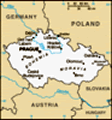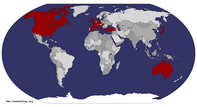Advertisement
I forgot to put the photo of the Kathe Kollwitz memorial sculpture in the last blog so it is the first image this time and a reminder that we left you at the ruined memorial church in Berlin.
Since then we have feasted our eyes on wondrous church architecture in three countries.
From Berlin the first stop was Quedlinburg, a town with roots back the 900’s to a time when Kaiser Otto 1 needed to protect the Empires eastern border and to’missionise’ the local Slavs. Both Deanna and Gerd (who has been there many times) had raved about this small fortified town and after our visit we can understand why and would recommend it to any visitor to Germany. We also discovered a gem of a Feininger Gallery there but more of that at a later time.
The Abbey church at Quedlinburg was built over the remains of an old pagan temple and sits next to the castle (which has sumptuous Baroque and Rococo décor) atop the only hill in the small town that is largely preserved in the style of the Middle Ages. The church is plain and austere and contains some beautiful religious pieces and jewellery

 Quedlinburg castle
Quedlinburg castle
The view from our lodgings to the castel which was a convent in Medieval timesin a special crypt. Some of the pieces have only just been returned after being souvenired by a US soldier after WW2. It was only on his death when one piece was put up for sale by his children that they found the treasures and after a court case got back all but two. At Gernrode, a few miles away is the Protestant Collegiate Church of St Cyriakus a 3 aisled cruciform basilica. It is now one of the oldest crypts in Germany even allowing for the numerous renovations and alterations. The Ottonian and Romanesque features are effectively plain both inside and outside.
A mandatory whistle stop for us was Leipzig to see St Thomas where Bach was a resident musician. Even though we were too late to go inside the church it was a magnificent sight with its steeply sloped roof completed during the recent restoration. A new Bach organ has been installed following the style that Bach would have used. Deanna would dearly have loved to see this as I think you can see from the photo!
Two days in Dresden was a treat for all of us and we managed to again get lost a

 View from Quedlinburg castle
View from Quedlinburg castle
The view from the battlements down into the roofs of the little medieval housesfew times. We always stopped “to ask a local for directions” and that lead to some amusing times. In Dresden two guys rushed to assist - one couldn’t speak English or German and the other one, who kept pushing the first out of the way, was deaf and dumb and could only use sign language!! We drove on still mystified and the next one had such poor eyesight that he pulled out a very large magnifying glass to even be able see our map! We felt as if we had struck the 3 wise monkeys in the one city and kept breaking up every time we thought about it - such are the adventures of travelling by car in strange places!
Dresden, the beloved city of Germans was largely destroyed during the bombing raids of February 15 1945 and the Frauenkirche (Church of Our Lady) has recently reopened after a massive rebuilding program supported by donations from around the world. Luckily for us, Gerd managed to sweet talk them into letting us into a service even though the doors had closed and we stood enthralled as the organ music filled the church. Originally built in the early 1700’s the

 Leipzig - St Thomas
Leipzig - St Thomas
Bach lived in the house oppositeRococo interior has been beautifully painted and restored. You could just imagine the populace being filled with religious fervour in such an overwhelming setting.
Culture also thrived in this significant city and we visited the Semper Opera House, built in 1878, destroyed in 1945, reopened in 1985 after reconstruction, which is very sumptuous and beautiful. It must be magnificent to attend an opera there.
Gerd had a special treat when he managed to talk his way into the VW factory and testing facility in the middle of Dresden after we had been told there was no room for visitors. He not only saw the robotics in action but he ‘test drove’ on a simulator the latest model and took it to over 200 k’s an hour. At least it was that fast when he had the time to look! Whilst he was there Col rode the trams and went to the Transport Museum.
Moving from Germany to Czechoslovakia was to step back in history. In this small country there are over 2000 surviving castles and palaces, however many are in urgent need of restoration and we only had time to see a couple. In Prague we visited

 Leipzig - St Thomas 2
Leipzig - St Thomas 2
Deanna's face shows the envy that was oozing out of her. This church was a mecca for famous musicians and she couldn't get in!the castle and whilst the castle was interesting St Vitus Cathedral in the castle grounds blew us all away. Prince Wenceslas (the one from the Good King song!) back in 929 was responsible for the first church, and then in the 11thcentury they built a Romanesque basilica which was replaced by a Gothic Cathedral in 1344. Numerous changes occurred to overlay the Renaissance and Baroque architecture and inside there is the most exquisite Rococo silver funerary monument from 1733. Talk about a visual architectural feast. Phil this really is architecture boot camp all over again!
The “must visit” place that we wanted to see was Cesky Krumlov, a well preserved medieval town which is a UNESCO World Heritage site. Col had read about it before we left Australia in the SMH travel section and it was well worth the detour to the Czech s/w corner after we spent a day wandering through small back roads and beautiful views to get there. Traces of settlement go back to 6000 BC and with its proximity to Austria there are links to the Bohemian Rosenbergs, the Eggenbergs from the Graz area of Austria and the Scharwzenbergs from Germany. Col and I are

 Frauenkirche
Frauenkirche
talk about "blow you away" when the organ soars so does everyone there - just the effect they were after.much more up on our European history than we’ve ever been and have learnt much about the links between rulers and countries. Whilst we did the obligatory church, it was the castle with its medieval theatre perched above the town that we will always remember plus the ambience of this village situated within a meander of the fast running Vltava River. Again highly recommended.
The theatre is the only remaining working example of a Baroque theatre in the world. Built in 1765 it is unique in that it has the original stage, seating, technical equipment (sound effects etc), decorations and costumes. The art of illusion was at its height and the stage whilst appearing to stretch into the distance deep is actually only 10 metres deep. Under the stage we saw the equipment that enabled them to change the complete set in 10 seconds. We all noted that it takes much longer at the Opera House!
Wandering through the town, eating and sitting by the river and just exploring was a lot of fun as was discovering that Egon Schiele’s mother was from Cesky and that he had lived and painted there for a time but this and
other art are for a later posting.
We drove from Cesky via the autobahn, into Austria and then Hungary, to Buda and Pest. Until you have seen these two noticeably old cities sitting astride the Danube, it is difficult to appreciate the historical impact of a river in the life of medieval people. With the advent of modern tourism as a major income earner the river remains a vital element for the visitor and the locals.
Budapest is a city that Deanna knows well from all her trips to Hungary for her Kodaly work so once settled into a hotel on her advice we ventured up to view the city at dusk from the Fishermen’s Bastion in the Castle Quarter. Our church visit here was to Mathais Church which sits atop the Citadel area and can be seen from miles away. Whilst the church dates back to 13th-15th centuries it is the major renovation in 1896, when some fantastic artists redid the decoration, that defines the mood and atmosphere. Painted designs fill every centimeter of wall and ceiling and are a rich blending of traditional Hungarian, Turkish and Art Nouveau design work. The painted abstract florals, stripes, geometric

 Dresden Opera House 2
Dresden Opera House 2
Look at the fabulous decoration above the columns in the corridor.shapes and eastern motifs were done in a subtle range of dark earthy tones. I could have stayed all night there and could only imagine how wonderful it would be to hear a choir in that huge space. Like most other churches we saw Mathais is undergoing renovation that will take a number of years to complete.
With the castles and major buildings lit up at night it became a fantasy world and after dinner we wandered through the city and over the river to our hotel. The weather was balmy and it was very peaceful. Our European history lessons continued the next day at the Hungarian National Museum and then we finished our time in Budapest when we went for scrumptious coffee and cake at Gerbeaud which is famous for its desserts. More next time from the intrepid four as we continue through Hungary and on into Austria.
Advertisement
Tot: 0.06s; Tpl: 0.014s; cc: 8; qc: 24; dbt: 0.0276s; 1; m:domysql w:travelblog (10.17.0.13); sld: 1;
; mem: 1.1mb






















PG
non-member comment
Wow... European history is complex and nothing beats being there where it all happened. Wonderful to see such a powerful educational junta from Aussie spreading good vibes. Happy travels.